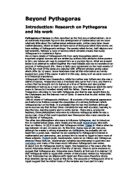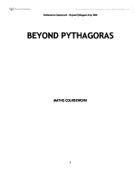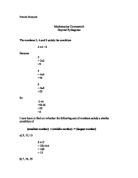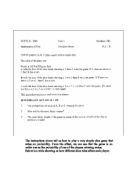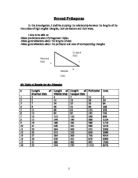Investigation into a driving test.
Investigation into a driving test By Declan Gervin I downloaded the following database from the Internet. Number of Number of Gender hour lessons minor mistakes Instructor Day Time M 8 3 A Mon 7.00 M 9 9 A Wed 9.00 M 4 0 A Fri 3.00 F 5 1 A Mon 9.00 F 5 5 A Tue 5.00 F 5 2 A Mon 4.00 F 20 8 A Wed 0.00 F 20 4 A Fri 9.00 F 20 9 A Mon 3.00 M 20 1 A Fri 9.00 M 20 2 A Thur 4.00 M 20 9 A Fri 9.00 M 20 8 A Mon 0.00 F 8 0 A Wed 0.00 F 0 A Thur 9.00 F 0 4 A Thur 0.00 F 1 3 A Fri 3.00 F 3 4 A Wed 3.00 M 5 4 A Mon 5.00 M 5 9 A Fri 0.00 M 6 4 A Wed 7.00 M 7 0 A Fri 1.00 F 23 5 A Mon 9.00 F 25 6 A Mon 5.00 F 27 5 A Fri 4.00 M 8 6 A Fri 3.00 M 9 9 A Thur 0.00 M 9 3 A Mon 2.00 F 5 1 A Wed 9.00 F 5 9 A Mon 6.00 F 9 3 A Fri 6.00 F 22 4 A Thur 6.00 M 24 5 A Mon 7.00 M 25 4 A Fri 0.00 M 26 3 A Wed 7.00 M 27 2 A Tue 7.00 F 6 5 A Mon 2.00 F 7 6 A Wed 0.00 M 21 8 A Thur 6.00 M 22 7 A Thur 7.00 F 5 27 A Fri 4.00 F 30 2 A Fri 0.00 F 1 7 A Mon 6.00 M 7 8 A Tue 5.00 F 2 3 A Thur 7.00 M 8 31 A Wed 0.00 M 6 23 A Mon 1.00 F 23 4 A Wed 4.00 M 9 9 A Thur 2.00 F 6 7 A Fri 9.00 M 4 8 A Fri 7.00 M 9
Research on Pythagoras and his work.
Beyond Pythagoras Introduction: Research on Pythagoras and his work Pythagoras of Samos is often described as the first pure mathematician. He is an extremely important figure in the development of mathematics yet we know relatively little about his mathematical achievements. Unlike many later Greek mathematicians, where at least we have some of the books which they wrote, we have nothing of Pythagoras's writings. The society which he led, half religious and half scientific, followed a code of secrecy which certainly means that today Pythagoras is a mysterious figure. We do have details of Pythagoras's life from early biographies which use important original sources yet are written by authors who attribute divine powers to him, and whose aim was to present him as a god-like figure. What we present below is an attempt to collect together the most reliable sources to reconstruct an account of Pythagoras's life. There is fairly good agreement on the main events of his life but most of the dates are disputed with different scholars giving dates which differ by 20 years. Some historians treat all this information as merely legends but, even if the reader treats it in this way, being such an early record it is of historical importance. Pythagoras's father was Mnesarchus, while his mother was Pythais and she was a native of Samos. Mnesarchus was a merchant who came from Tyre, and
Beyond Pythagoras
BEYOND PYTHAGORAS MATHS COURSEWORK INTRODUCTION Pythagoras was a Greek mathematician and philosopher. He lived in 400 BC and was one of the first great mathematical thinkers. He spent most of his life in Sicily and southern Italy. He had a group of follows who went around and thought other people what he had taught them who were called the Pythagoreans. Pythagoras himself is best known for proving that the Pythagorean Theorem was true. The Sumerians, two thousand years earlier, already knew that it was generally true, and they used it in their measurements, but Pythagoras proved that it would always be true. The Pythagorean Theorem says that in a right triangle, the sum of the squares of the two right-angle sides will always be the same as the square of the hypotenuse (the long side). A2 + B2 = C2 Pythagoras theorem can also help in real life. Here is an example: Say you were walking though a park and wanted to take a short cut. With Pythagoras's theorem you could work out exactly how long you would have to walk though the grass, rather then talking the long route by walking on the paths. PLAN I am going to investigate the three triangles I have been given. They are all right-angled triangles, with 3 sides, all different lengths. The three triangles satisfy the Pythagoras theorem. The theorem states that the hypotenuse side (longest side) must equal the 2 shorter
Beyond Pythagoras - Year 10 Maths Coursework
Beyond Pythagoras - Year 10 Maths Coursework By Nadia House 10G The numbers 3, 4 and 5 satisfy the condition 3²+4²=5², Because 3²= 3x3 =9 4²= 4x4 =16 5²= 5x5 =25 And so... 3²+4² (=9+16) = 25 (=5²) I now have to find out if the following sets of numbers satisfy a similar condition of: Smallest number² + Middle number² = Largest number² (S² + M = L²) a) 5, 12, 13 5² + 12² = 13² ~ (25 + 144 = 169) b) 7, 24, 25 7²+24² = 25² ~ (49 + 576 = 625) Here is a table containing the results: Short Side Middle Side Long Side 3 4 5 5 2 7 24 25 I looked at this table and noticed that there was only a difference of 1 between the length of the middle side and the length of the longest side. I already know that the Smallest number² + Middle number² = Largest number². So I know that there will be a connection between the numbers written above. The only problem is that it is obviously not: Middle Side² + Large Side² = Small Side² Because, 12² + 13² = 144 + 169 = 313 and 5² = 25 The difference between 25 and 313 is 288 which is far to big, so this means that the equation I want has nothing to do with 3 sides squared. I will now try 2 sides squared. M² + L = S² = 12² + 13 = 5² = 144 + 13 = 25 = 157 = 25 This does not work and neither will 13², because it is larger than 12². There is also no point in squaring the largest
Beyond Pythagoras
Beyond Pythagoras In this piece of coursework I will be exploring Pythagorean triples which are beyond Pythagoras. Pythagoras is where you have a right angled triangle and you know the values of sides a + b but you don't know what side c is (hypotenuse). To calculate the hypotenuse you can square sides a + b and add the two answers together as one total. This total is equal to c2 so all you have to do now is find the square root of the total and you have worked out side c. A Pythagorean triple is where the first two sides of a triangle (a + b) suit this equation: a2 + b2 = c2. For example lets say a=1, b=2, c=3. Now let's try this in a Pythagoras equation: a2 + b2 = c2 (12 + 22 = 32) this is not correct!!! 12 + 22 = 5 we should know that 32 = 9!!!! From this we should acknowledge that the 3 numbers I used don't fit the equation a2 + b2 = c2, this therefore means they are not Pythagorean triples!!!! So from this you should notice that a2 + b2 = c2, if a=3, b=4, and c=5 (32+44 = 52) we can see that 32 + 42= 52(25) this therefore means these numbers make a Pythagorean triple. I have been given 3 sets of Pythagorean triples from family 1 to analyse: I've been told that family 1 of the Pythagorean triples has the following features: ?smallest side is odd ?the longest side is one more than the middle side ?on the middle side you add 4 more on than the last time If I
Mathematics Coursework - Beyond Pythagoras
Mathematics Coursework Beyond Pythagoras The numbers 3, 4 and 5 satisfy the condition 3 +4 =5 Because 3 = 3x3 =9 4 = 4x4 =16 5 = 5x5 =25 So 3 +4 =9+16 =25 =5 I now have to find out whether the following sets of numbers satisfy a similar condition of (smallest number) + (middle number) = (largest number) a) 5, 12, 13 5 +12 = 25+144 = 169 = 13 b) 7, 24, 25 7 +24 = 49+576 = 625 =25 I looked at the table of results and noticed that there was only a difference of 1 between the length of the middle side and the length of the longest side. I already know that the (smallest number) + (middle number) = (largest number) . So I think that there might be a connection between the numbers. The problem is that this is not completely correct. (Middle number) + (largest number) = (smallest number) Because 12 + 13 = 144+169 = 313 5 = 25 The difference between 25 and 313 is 288 which is far to big, so this means that the equation I need and want has nothing to do with 3 sides being squared. So I shall now try 2 sides being squared. (middle number ) + largest number = (smallest number) = 12 + 13 = 52 = 144 + 13 = 25 = 157 = 25 This does not work. There is also no point in squaring the largest and the smallest or the middle number and the largest number. I will now try 1 side being squared. 12 + 13 = 5 This couldn't work
Dice Maths Investigation
The instructions above tell us how to play a very simple dice game that relies on probability. From the offset, we can see that the game is an unfair one as the probability of one of the players winning varies. Below is a table showing us how different dice roles affect each player. Dice Number 2 3 4 5 6 A Wins B Wins C Wins We can see that the distribution of numbers is not even. However, the probability of each player winning is conditional because if A throws a one, the game finishes and B does not get a chance to throw. To illustrate this more clearly I have created a conditional probability tree diagram: From this simple diagram, the following results are easily obtainable: st Round 2nd Round 3rd Round 4th Round A 1/6 5/108 25/1944 25/34992 B 5/18 25/324 25/5832 625/104976 C 5/18 25/324 25/5832 625/104976 The most important thing I found that each probability had in common with one another, except Player A's first term, was that all the numbers on top were divisible by five and that all the bottom numbers were divisible by 18: 25/5 = 5...324/18 = 18...625/5 = 125...104976/18 = 5832. You will notice that when any of the probabilities are divided by 5/18 the result is the previous probability. This is because the probability of a player winning is multiplied by the probability of all the previous rounds passing. Seeing as the
Beyond Pythagoras
Beyond Pythagoras In this investigation, I shall be studying the relationship between the lengths of the three sides of right angled triangles, their perimeters and their areas. I aim to be able to: -Make predictions about Pythagorean triples -Make generalizations about the lengths of side -Make generalizations about the perimeter and area of corresponding triangles My Table of Results for the Triangles n Length of Shortest Side Length of Middle Side Length of Longest Side Perimeter Area 3 4 5 2 6 2 5 2 3 30 30 3 7 24 25 56 84 4 9 40 41 90 80 5 1 60 61 32 330 6 3 84 85 85 546 7 5 12 13 240 840 8 7 44 45 300 224 9 9 80 81 380 710 0 21 220 221 460 2310 1 23 264 265 552 3036 2 25 312 313 650 3900 3 27 364 365 756 4914 4 29 420 421 870 6090 5 31 480 481 992 7440 6 33 544 545 122 8976 The reason I used certain triples in my table (for example there is also another triple for 9 as the shortest side which has 12 as the middle side length and 15 as the hypotenuse) is because they followed the pattern I was looking at. Even though some of the other triple combinations might have worked, I chose the ones out of them which went best with the other combinations. The 9,40,41 triple has a difference of 1 between its middle and longest side lengths, which is what the other triples
Beyond Pythagoras P.1 Pythagoras Theorem is a2+b2= c2 'a' is being the shortest side, 'b' being the middle side and 'c' being
Mahmoud Elsherif Beyond Pythagoras P.1 Pythagoras Theorem is a2+b2= c2 'a' is being the shortest side, 'b' being the middle side and 'c' being the longest side (hypotenuse) of a right angled triangle. The numbers 3,4,5 satisfy this condition and so 32+ 42=52 Because 32= 3*3=9 42=4*4=16 52=5*5=25 32+ 42=52 9+16=25 25=25 This proves Pythagoras Theorem goes with the right angled triangle with the numbers 3,4,5. Next I shall prove that Pythagoras's Theorem applies to 5,12,13 right angled triangle. 52+122=132 Because 52= 5*5=25 22= 12*12=144 32= 13*13=169 Mahmoud Elsherif Beyond Pythagoras P.2 This satisfies the Theorem of Pythagoras's goes with these numbers 5,12,13. Finally I shall prove that Pythagoras's Theorem applies to 7,24,25 right angled triangle. 72+ 242=252 Because 72= 7*7=49 242= 24*24= 576 252=25*25=625. So a2+b2=c2 72+242=252 49+576=625 This proves Pythagoras Theorem goes with the right angle triangle with the sides 7,24,25 Shortest Side Middle Side Longest Side 3 4 5 5 2 3 7 24 25 9 40 41 1 60 61 3 84 85 Mahmoud Elsherif Beyond Pythagoras P.3 I shall find the prediction of the shortest side first. 3,5,7 It goes up in 2 so in my conclusion so it will become 3,5,7,9,11,13 Now I will find the difference between them. The difference is 2 Next I shall find the prediction
Beyond Pythagoras
Mahmoud Elsherif Beyond Pythagoras P.1 Pythagoras Theorem is a2+b2= c2 'a' is being the shortest side, 'b' being the middle side and 'c' being the longest side (hypotenuse) of a right angled triangle. The numbers 3,4,5 satisfy this condition and so 32+ 42=52 Because 32= 3*3=9 42=4*4=16 52=5*5=25 32+ 42=52 9+16=25 25=25 This proves Pythagoras Theorem goes with the right angled triangle with the numbers 3,4,5. Next I shall prove that Pythagoras's Theorem applies to 5,12,13 right angled triangle. 52+122=132 Because 52= 5*5=25 22= 12*12=144 32= 13*13=169 Mahmoud Elsherif Beyond Pythagoras P.2 This satisfies the Theorem of Pythagoras's goes with these numbers 5,12,13. Finally I shall prove that Pythagoras's Theorem applies to 7,24,25 right angled triangle. 72+ 242=252 Because 72= 7*7=49 242= 24*24= 576 252=25*25=625. So a2+b2=c2 72+242=252 49+576=625 This proves Pythagoras Theorem goes with the right angle triangle with the sides 7,24,25 Shortest Side Middle Side Longest Side 3 4 5 5 2 3 7 24 25 9 40 41 1 60 61 3 84 85 Mahmoud Elsherif Beyond Pythagoras P.3 I shall find the prediction of the shortest side first. 3,5,7 It goes up in 2 so in my conclusion so it will become 3,5,7,9,11,13 Now I will find the difference between them. The difference is 2 Next I shall find the prediction of



